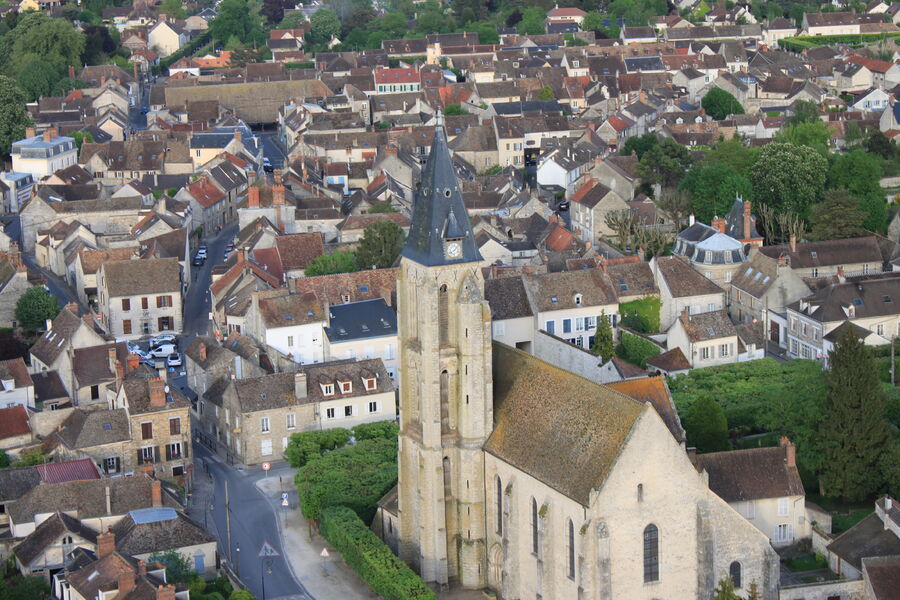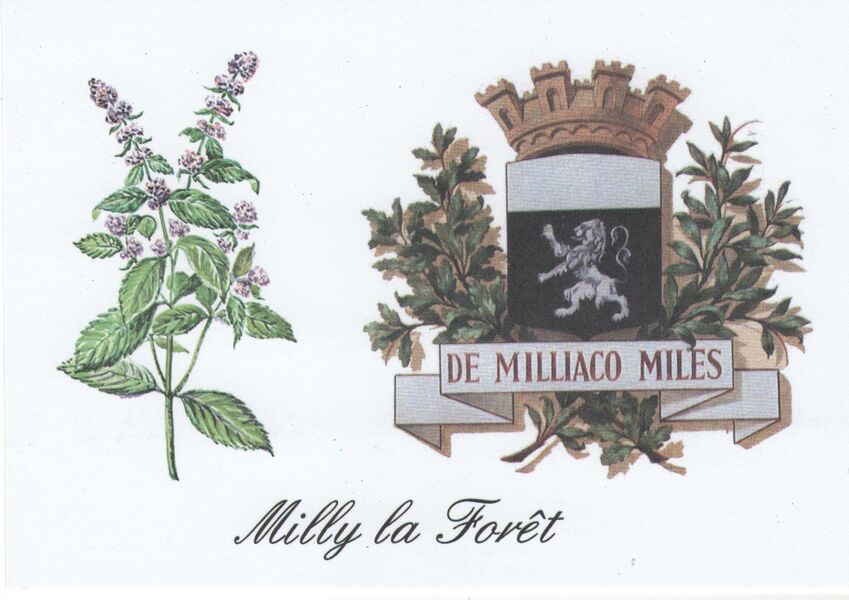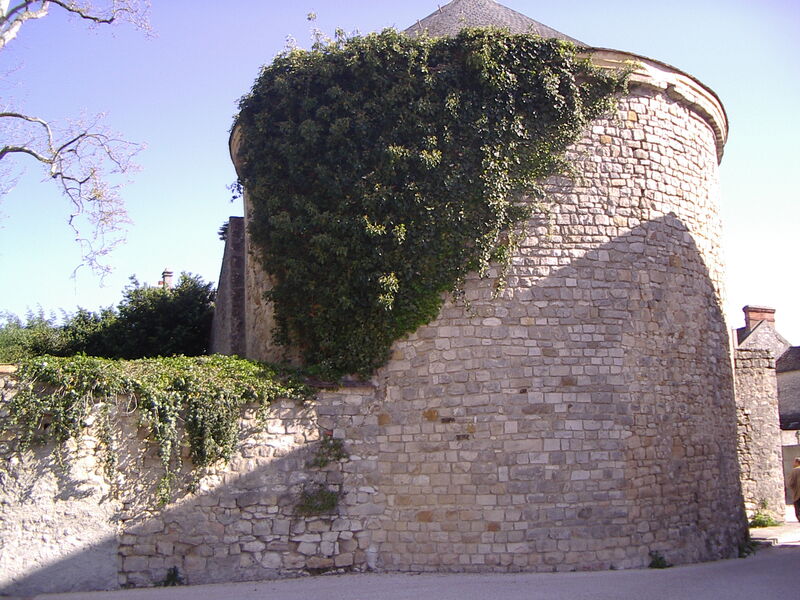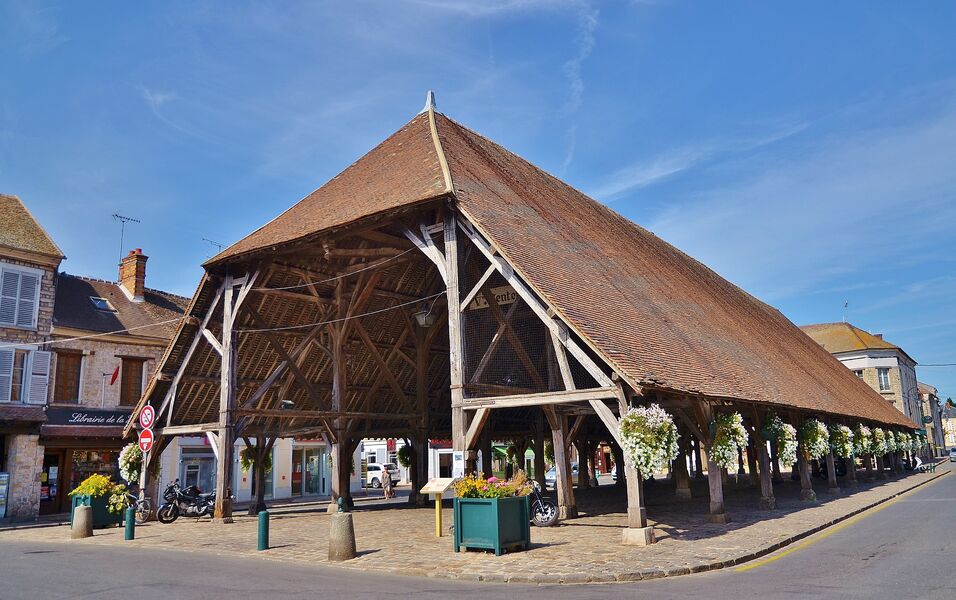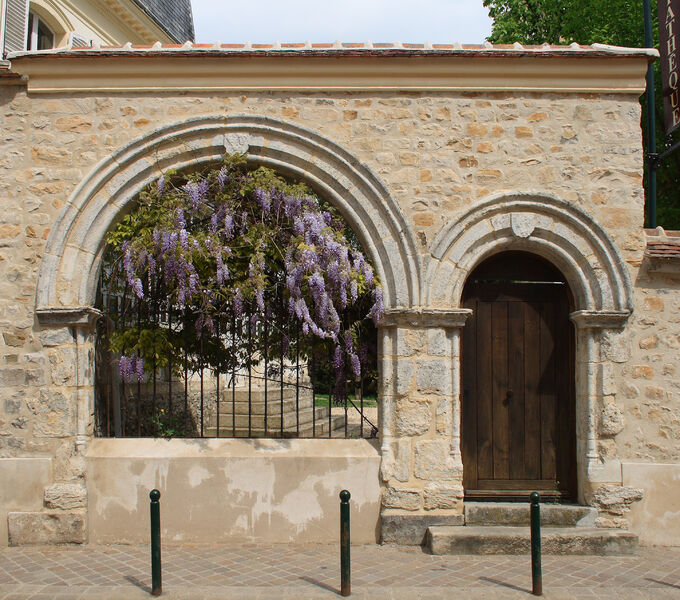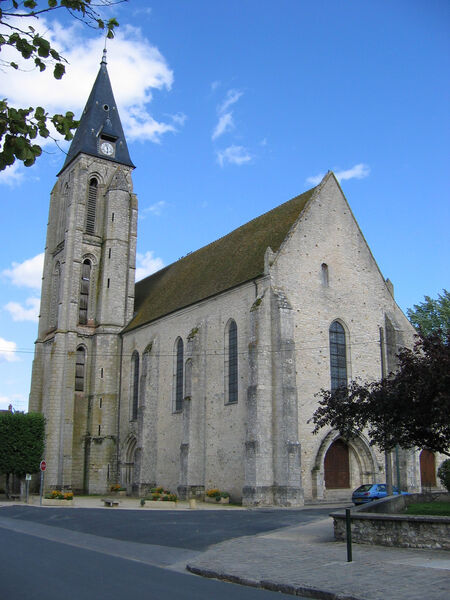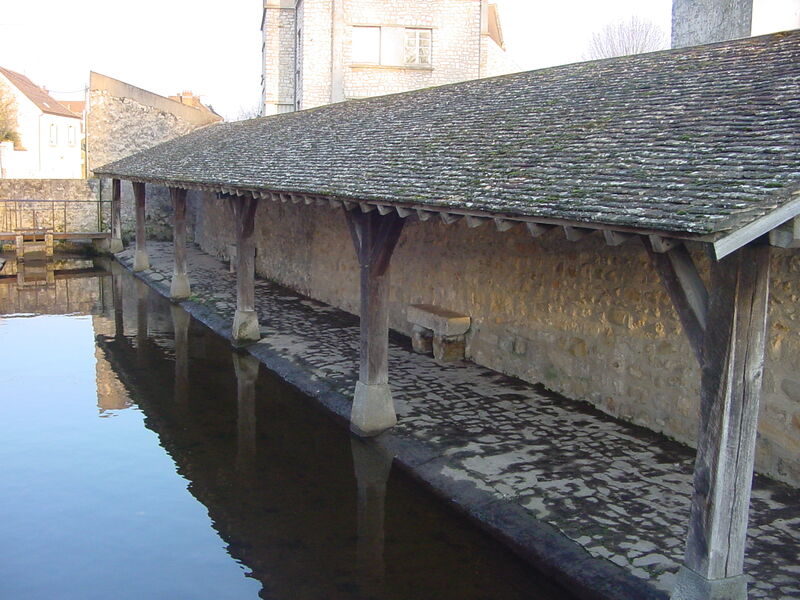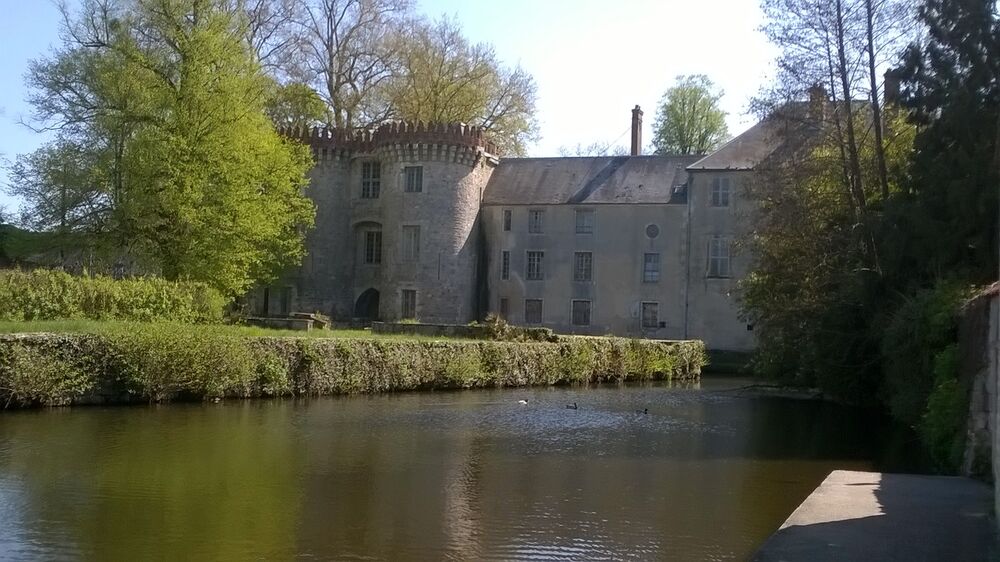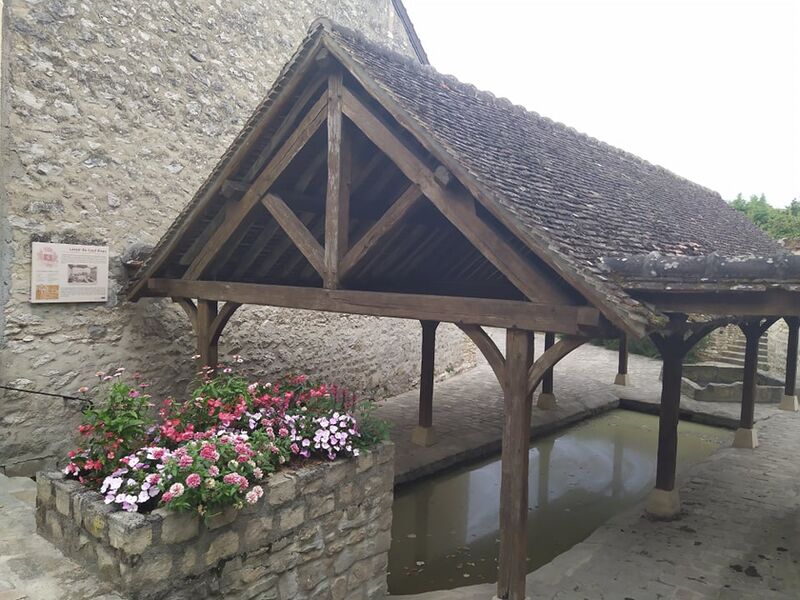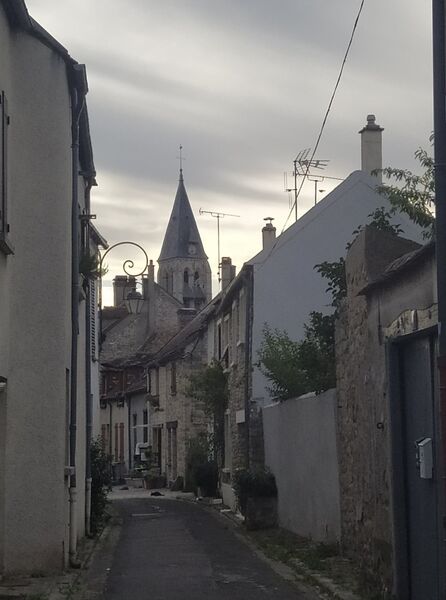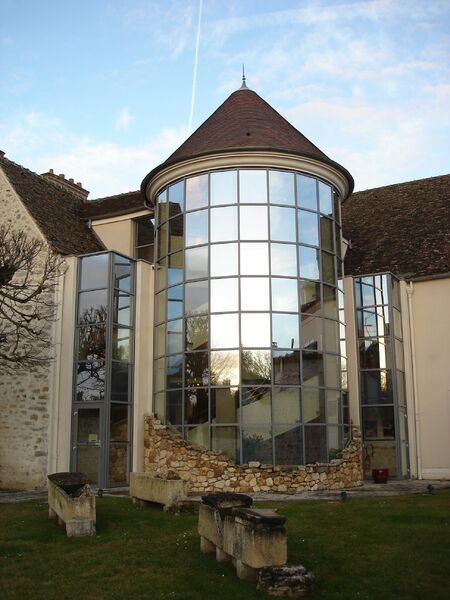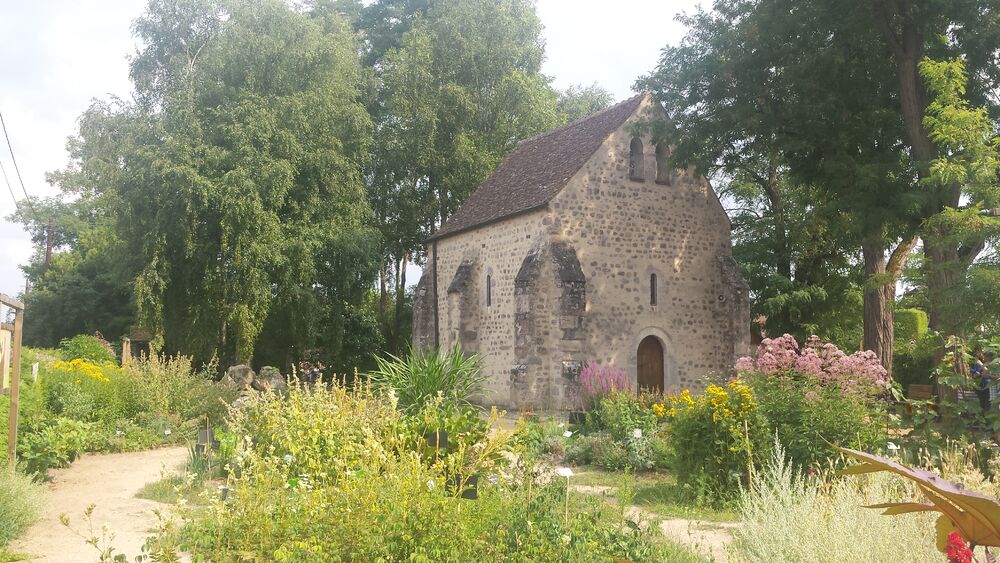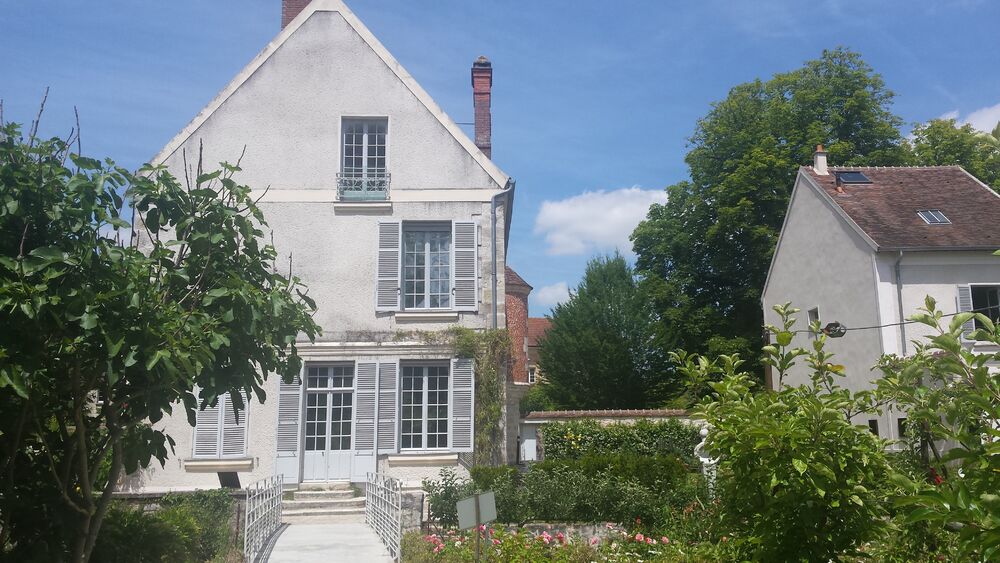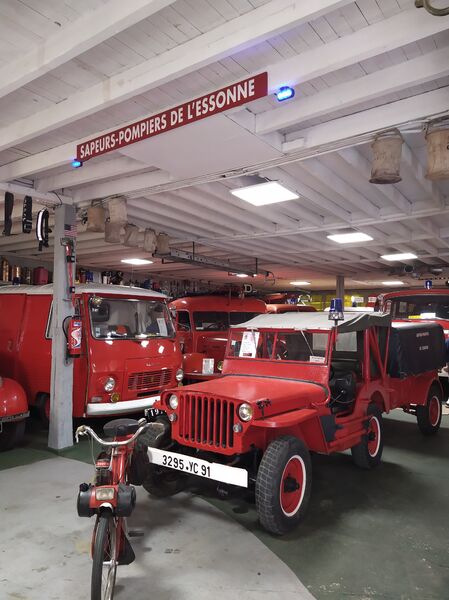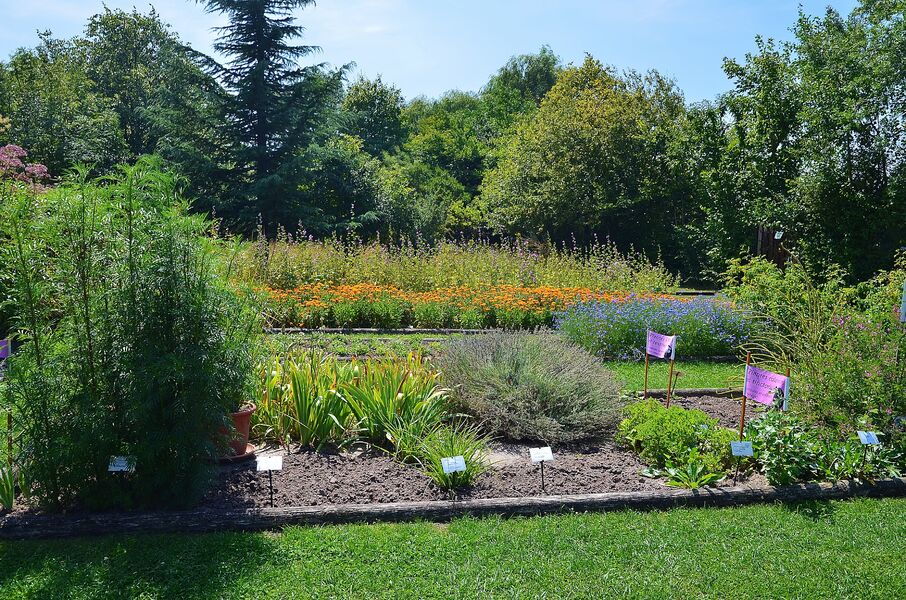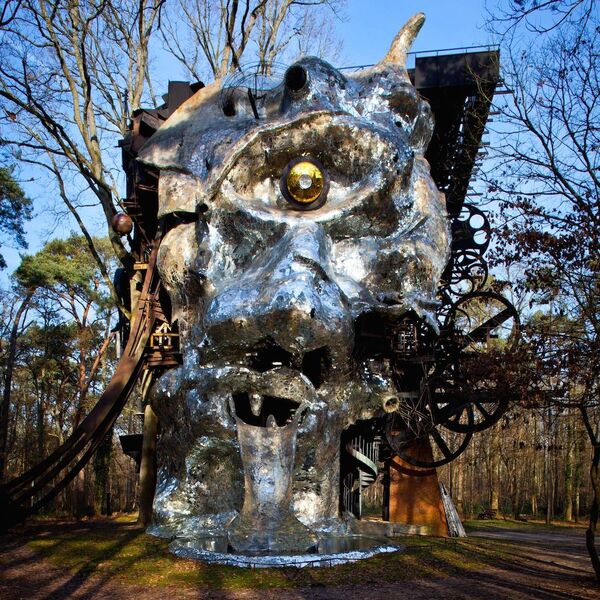Milly la Forêt
Milly-la-Forêt
Patrimoine culturel
Milly-la-Forêt is located in the École Valley, nearly 50 kilometers from the South of Paris. It is a very important tourist hub in Essonne and it is also the capital city for aromatic and medicinal plants.
-------------
HISTORY
The name of Milly-la-Forêt could come from the Gallic name of “Maurillac''. The old borough of Milly has been founded in nearly 285 B.C. and it was the firstly a place for druidic initiation. The Menhir de la Pierre Droite is dating from this same period of time and it was surely used for ceremonies and rituals.
During the Roman Gaul era, Milly was crossed by the Roman road located Chemin de Grimery where a lot of relics were found such as coins and medals during previous archeological digs. We also know that a Roman camp could have been installed not far from the city.
In the 7th century, the estate of Maurillacum was the property of Fulbert 1st who was a royal officer for Franks King Dagobert 1st. The king was himself crowned in Milly. It was in nearly 640 that Fulbert’s son Saint Wulfram was born in Milly. Wulfram was well known because he converted Friesland region in the Netherlands. He also has been the archbishop of Sens, the most important archdiocese in France for centuries. When Wulfram died, his estate of Milly was given to King Charles Martel.
Then, the estate had several different owners through time following wars and manigances : the French King, some deserving lords, the Church,... During the 12th century, the estate was owned by the Church and they built the Saint-Blaise-des-Simples chapel. It is the only one vestige remaining from the old leprosarium where lepers were isolated and treated.
During the Middle Age, the city was regularly visited by Kings of France, whether it was for hunting, affairs of State or weddings between different important noble families. After the defeat in Poitiers during the Hundred Years War, Englishmen arrived in Milly, they looted and leveled the whole city. A few years later, the army of the famous Black Prince Edward of Woodstock captured the city.
During the 15th century the city was the property of Louis Malet de Graville, admiral of France. Under his influence, Milly was rebuilt to give it back its former glory : new fortifications were added, the market hall was built, the castle and the church were restored. It is also thanks to Louis Malet de Graville that Milly got one of the most important fairs of Ile-de-France. The city was also crossed at the time by a road going to Lyon.
King Henri IV was often coming to Milly-la-Forêt as a resting stage when he was going to see his numerous mistresses in Fontainebleau and Malesherbes. However, the city slowly lost its attractivity when King Louis XIV decided that the road to Lyon would cross Fontainebleau instead of Milly.
During the 19th century, the city was affected by the second cholera epidemic and then by battles during the Franco-Prussian war. During this war, several inhabitants were held hostage by Germans who also occupied the castle.
During World War I, Milly-la-Forêt hosted a training center for several African regiments and American army. A tramway line was once going from Milly-la-Forêt to Melun from 1910 until the beginning of World War II. Numerous members of the Resistance were living in the city and around. Sadly, in the Plaine de Chanfroy, located in the middle of the forest le Massif des Trois Pignons, the Gestapo of Melun killed 36 members of the Resistance.
As of the half of the 20th century, Milly-la-Forêt was a trendy place for secondary houses for celebrities and artists. Some of the most famous inhabitants of the city were Jean Cocteau and Christian Dior.
-------------
HERITAGE
The Market Hall
In 1479, the admiral de Graville got the favour from King Louis 11 to build the famous market hall of Milly, to organize three fairs each year and a weekly market. The fair was so appreciated it quickly became one of the most important in Ile-de-France.
The market hall has a north-south exposure. It is 46 meters long, 16 meters wide and 13 meters high for a total of 730 square-meters. It is also composed of 48 pillars made of oak wood and a framework made of chestnut wood, they both have a typical architecture for market halls at the time. It was classified as part of the Monuments Historiques in 1923.
++++
The Church of Notre-Dame de l’Assomption
First of all, it used to be the chapel of the castle and was built during the 11th century. It was not until the 14th century that it became a parochial church. Sadly, it was damaged and even burnt, as the majority of the city, during the Hundred Years War. It was only around 1485 that it was rebuilt in a Gothic style thanks to the admiral Louis Malet de Graville who was the lord of Milly-la-Forêt at the time.
The lower part of the bell tower, which is 57 meters high, dates from the 11th century. On its East side, we can still see the coat-of-arms of the admiral de Graville. It is also visible on the keystones of the two arch’s spans. The coat-of-arms represents three metal clasps with golden buckles. The portal’s arch is supposed to come from the old church of Saint-Pierre.
The entry to church is effectuated by the western portal which was arranged during the 19th century. It is made of pieces of an older portal from the 12th century. At the time, a lot of work was done such as the pavement of the church. Inside the church, numerous pieces of art are classified. Remains of Saint-Wulfram are resting inside the reliquary. The church also has a modern art Christ on the cross from the artist Chomo. The church has been classified as part of the Monuments Historiques since 1926.
++++
The Estate de la Bonde (castle)
The first castle de la Bonde was built during the 12th century by the lords of Milly. In 1432, it was partly destroyed by Englishmen during the Hundred Years War. It was not until the end of the 15th century that the castle was rebuilt thanks to the admiral de Graville. The ancient dungeon is from the Middle Age and it became the castle entrance. The drawbridge and the harrow were replaced by a stone bridge, but we can still see some traces of the drawbridge and harrow onto the walls of the castle. Some canals were dug, the castle was expanded and a chapel was added. King Louis 11 stayed in the castle de la Bonde several times, as did several important persons from the royalty.
The castle had several lords throughout the years and they all were really close to the King, it changed a lot depending on the desires of the owners. The castle and its park were listed as part of the Inventaire des Sites in 1946 and then as part of the Inventaire des Sites Pittoresques with the church and the Maison de Jean Cocteau in 1972.
Also, we can count the wash-house de la Bonde as part of the estate de la Bonde. It was once used for quick laundry. It was restored in 1964. The wash-house and the trough are separated by the bridge de la Corne. The old trough was used by farmers so their cattle could drink and also it could cool down the wheels of the vehicles that were going to the castle.
++++
The Dovecote
Under the reign of Fulbert 1st, a monastery was built. It was mostly destroyed in 1432 by Englishmen during the Hundred Years War. The dovecote is one of the only vestiges remaining from the monastery.
In the past, dovecotes were a sign of wealth for cities who had one. Only the lord of the city was allowed to build a dovecote. The number of alcoves inside of it was reglemented by royal decree. The restoration of the dovecote started in 2021.
++++
The Door du Moustier de Péronne
It is one of the oldest vestiges still standing in Milly-la-Forêt, a perfect testimony of the rich history the city went through. This door was built during the 8th century and was used to enter the monastery (the word “moustier” is the old French name for monastery) under the reign of Fulbert 1st. The monastery occupied a large portion of the city at the time. Nowadays, the monastery is not visible anymore as it was destroyed during the Hundred Years War. The only remaining are the dovecote, the door du Moustier de Péronne and a crypt with beautiful central pillars with capitals. The crypt is sometimes used for art exhibitions
++++
L' Espace culturel Paul Bédu (a museum with art exhibitions)
Paul Bédu was a very rich man who was a descendant of an old family from Milly-la-Forêt. He was passionned by art and spent his whole life buying pieces of art until his death in 1977. In 1990, his widow Gabrielle Lagarde decided to honour his memory by bequeathing his entire collection of art to the city of Milly-la-Forêt. She subsidized the works done onto the old boy’s school to make it the Espace Culturel Paul Bédu as we see it nowadays. It was inaugurated on the 24th of June 2000. The museum has a permanent collection and also hosts some temporary exhibitions.
The personal collection of Paul Bédu is composed of drawings, paintings, sculptures and works of art. He was an amateur of landscapes, nudes, portraits and still-life paintings. Among other things in his collection, there is a painting called “La Vierge à l’Enfant”, a gothic statue from the 15th century and a lot of graphic works made by Marie Laurencin.
The museum has the pride of possessing the very famous painting called “Et le Soleil s'endormit sur l’Adriatique” by the mysterious Joachim Raphaël Boronali. In fact, this painting was made by Lolo, a donkey. This painting was a whole hoax made by Roland Dorgelès who wanted to make fun of the art critics at the time. He attached a paintbrush to the donkey’s tail to make this painting. The museum also exhibits different pieces of contemporary arts made by Jean Cocteau and Niki de Saint-Phalle.
-------------
TOURIST SITES
The Chapel of Saint-Blaise-des-Simples
The chapel of Saint-Blaise-des-Simples was built during the 12th century when Milly’s territory belonged to the Church. The chapel was part of the leprosarium, a place where lepers were isolated and treated. The chapel was used to pray to Saint-Blaise, the saint known for healing sickness thanks to plants.
The chapel was abandoned during the 18th century but had several utilities throughout the years : it was used as a prison, a shed or a dryer. In 1959, Jean Cocteau was solicited by the mayor of Milly to decorate the chapel. He created some stained-glass windows and painted wall frescos. They all represent the resurrection of Christ, simplicis herbae and medicinal plants. Those plants are still cultivated in the small garden surrounding the chapel. They all had the reputation to heal people who got leper.
Since 1964, Jean Cocteau has been buried in the center of the chapel as he wished with his last boyfriend Edouard Dermit. On their tombstone have been engraved a few words he wrote about fidelity : “I stay with you”.
Depuis 1964, Jean Cocteau repose au centre de la chapelle selon son souhait avec son dernier compagnon Edouard Dermit. Sur la dalle sont gravés quelques mots de fidélité : “Je reste avec vous”.
++++
The House of Jean Cocteau
In 1947, Jean Cocteau decided to live in Milly-la-Forêt with his boyfriend at the time, the famous French actor Jean Marais. They bought together a house which was an old dependency from the castle de la Bonde. A lot of work was done and an art studio was arranged in the attic.
Cocteau lived in Milly for 17 years until his death in 1963, firstly he lived there from time to time and then definitively once he met his last boyfriend Edouard Dermit. Dermit took care of the house and of Cocteau’s works until his own death in 1995.
After that, Pierre Bergé, who was a friend of Cocteau and the president of the association Maison de Jean Cocteau, bought the house in 2002 with the help of the Conseil Général de l’Essonne and the Conseil Régional d’Ile-de-France. They made it a museum about Jean Cocteau, his life and creations, and it opened 2010 after years of renovation. Since Pierre Bergé death in 2017, the Région Ile-de-France has been managing the museum.
The scenography of the museum was done by Dominique Païni and Nathalie Crinière. People can follow Cocteau’s steps through three rooms replenished as it was when Cocteau lived here : a big living room where we can see a painting done by Christian Bérard, the bedroom and his office with its original furniture. The visit is punctuated by pieces of his life and his creations throughout drawings or photographs.
++++
Le Conservatoire National des Plantes (The National Conservatory for Plants)
Milly-la-Forêt always had a reputation for centuries to be the French capital city for aromatic and medicinal plants, so it was natural to install here the Conservatoire National des Plantes. It is located in an old plants dryer and it is a real place to learn where plants are protected and valued. It is also used as a plant nursery, a botanical garden, an agronomic center and an interpretation center. The place also has a garden fathering more than 1 500 different plants’ species. It is an invitation to a sensory discovery. Also, there is a detailed museography retracing the history of plants throughout the centuries.
++++
The Cyclop of Jean Tinguely
The Cyclop is a sculptural work made of concrete, metal and partly covered in mirrors. It is as high as a seven storey building and located in the middle of the woods called Bois des Pauvres in Milly-la-Forêt. This colossal sculpture was created between 1969 and 1994 by Jean Tinguely, his wife Niki de Saint Phalle and their artist friends.
When the couple was living in Dannemois, they decided to build the Cyclop, without any legal authorization and paid with their own money, hidden in a forest around Milly. They invited numerous artist friends to collaborate with them in a friendly ambiance. The Cyclop is composed of different recycled materials like mirrors, an old wagon, steel pipes and leftovers from their own construction site.
However, during the 80s, the sculpture got regularly damaged by acts of vandalism, so that Jean Tinguely contemplated several solutions such as concreting the place or moving the Cyclop somewhere else. Finally, Tinguely confided his sculpture to the French state in 1987 in exchange for its conservation.
25 years after the beginning of its construction, the Cyclop opened its doors to the public in 1994 following the will of Jean Tinguely who died 3 years prior. The Cyclop is classified as part of the Fonds National d’Art Contemporain, an art collection managed by the Centre National des Arts Plastiques.
++++
The Firemen’s Ecomuseum
The ecomuseum “La Passion du Rouge” (the passion for red colour) opened its doors in 2016. It is the only museum in Essonne honouring firemen. This museum has a nice collection of vehicles, objects and uniforms retracing the history of firemen from 1800 to nowadays. Different permanent exhibition rooms explain the daily life of firemen.
++++
SOURCE: Mairie de Milly-la-Forêt, Corpus Étampois, “Histoire du Gâtinais et de l'Hurepoix” de Don Guillaume Morin, Conservatoire National des Plantes, Les Amis de Milly-en-Gâtinais et Environs, Parc Naturel Régional du Gâtinais Français
HISTORY
The name of Milly-la-Forêt could come from the Gallic name of “Maurillac''. The old borough of Milly has been founded in nearly 285 B.C. and it was the firstly a place for druidic initiation. The Menhir de la Pierre Droite is dating from this same period of time and it was surely used for ceremonies and rituals.
During the Roman Gaul era, Milly was crossed by the Roman road located Chemin de Grimery where a lot of relics were found such as coins and medals during previous archeological digs. We also know that a Roman camp could have been installed not far from the city.
In the 7th century, the estate of Maurillacum was the property of Fulbert 1st who was a royal officer for Franks King Dagobert 1st. The king was himself crowned in Milly. It was in nearly 640 that Fulbert’s son Saint Wulfram was born in Milly. Wulfram was well known because he converted Friesland region in the Netherlands. He also has been the archbishop of Sens, the most important archdiocese in France for centuries. When Wulfram died, his estate of Milly was given to King Charles Martel.
Then, the estate had several different owners through time following wars and manigances : the French King, some deserving lords, the Church,... During the 12th century, the estate was owned by the Church and they built the Saint-Blaise-des-Simples chapel. It is the only one vestige remaining from the old leprosarium where lepers were isolated and treated.
During the Middle Age, the city was regularly visited by Kings of France, whether it was for hunting, affairs of State or weddings between different important noble families. After the defeat in Poitiers during the Hundred Years War, Englishmen arrived in Milly, they looted and leveled the whole city. A few years later, the army of the famous Black Prince Edward of Woodstock captured the city.
During the 15th century the city was the property of Louis Malet de Graville, admiral of France. Under his influence, Milly was rebuilt to give it back its former glory : new fortifications were added, the market hall was built, the castle and the church were restored. It is also thanks to Louis Malet de Graville that Milly got one of the most important fairs of Ile-de-France. The city was also crossed at the time by a road going to Lyon.
King Henri IV was often coming to Milly-la-Forêt as a resting stage when he was going to see his numerous mistresses in Fontainebleau and Malesherbes. However, the city slowly lost its attractivity when King Louis XIV decided that the road to Lyon would cross Fontainebleau instead of Milly.
During the 19th century, the city was affected by the second cholera epidemic and then by battles during the Franco-Prussian war. During this war, several inhabitants were held hostage by Germans who also occupied the castle.
During World War I, Milly-la-Forêt hosted a training center for several African regiments and American army. A tramway line was once going from Milly-la-Forêt to Melun from 1910 until the beginning of World War II. Numerous members of the Resistance were living in the city and around. Sadly, in the Plaine de Chanfroy, located in the middle of the forest le Massif des Trois Pignons, the Gestapo of Melun killed 36 members of the Resistance.
As of the half of the 20th century, Milly-la-Forêt was a trendy place for secondary houses for celebrities and artists. Some of the most famous inhabitants of the city were Jean Cocteau and Christian Dior.
-------------
HERITAGE
The Market Hall
In 1479, the admiral de Graville got the favour from King Louis 11 to build the famous market hall of Milly, to organize three fairs each year and a weekly market. The fair was so appreciated it quickly became one of the most important in Ile-de-France.
The market hall has a north-south exposure. It is 46 meters long, 16 meters wide and 13 meters high for a total of 730 square-meters. It is also composed of 48 pillars made of oak wood and a framework made of chestnut wood, they both have a typical architecture for market halls at the time. It was classified as part of the Monuments Historiques in 1923.
++++
The Church of Notre-Dame de l’Assomption
First of all, it used to be the chapel of the castle and was built during the 11th century. It was not until the 14th century that it became a parochial church. Sadly, it was damaged and even burnt, as the majority of the city, during the Hundred Years War. It was only around 1485 that it was rebuilt in a Gothic style thanks to the admiral Louis Malet de Graville who was the lord of Milly-la-Forêt at the time.
The lower part of the bell tower, which is 57 meters high, dates from the 11th century. On its East side, we can still see the coat-of-arms of the admiral de Graville. It is also visible on the keystones of the two arch’s spans. The coat-of-arms represents three metal clasps with golden buckles. The portal’s arch is supposed to come from the old church of Saint-Pierre.
The entry to church is effectuated by the western portal which was arranged during the 19th century. It is made of pieces of an older portal from the 12th century. At the time, a lot of work was done such as the pavement of the church. Inside the church, numerous pieces of art are classified. Remains of Saint-Wulfram are resting inside the reliquary. The church also has a modern art Christ on the cross from the artist Chomo. The church has been classified as part of the Monuments Historiques since 1926.
++++
The Estate de la Bonde (castle)
The first castle de la Bonde was built during the 12th century by the lords of Milly. In 1432, it was partly destroyed by Englishmen during the Hundred Years War. It was not until the end of the 15th century that the castle was rebuilt thanks to the admiral de Graville. The ancient dungeon is from the Middle Age and it became the castle entrance. The drawbridge and the harrow were replaced by a stone bridge, but we can still see some traces of the drawbridge and harrow onto the walls of the castle. Some canals were dug, the castle was expanded and a chapel was added. King Louis 11 stayed in the castle de la Bonde several times, as did several important persons from the royalty.
The castle had several lords throughout the years and they all were really close to the King, it changed a lot depending on the desires of the owners. The castle and its park were listed as part of the Inventaire des Sites in 1946 and then as part of the Inventaire des Sites Pittoresques with the church and the Maison de Jean Cocteau in 1972.
Also, we can count the wash-house de la Bonde as part of the estate de la Bonde. It was once used for quick laundry. It was restored in 1964. The wash-house and the trough are separated by the bridge de la Corne. The old trough was used by farmers so their cattle could drink and also it could cool down the wheels of the vehicles that were going to the castle.
++++
The Dovecote
Under the reign of Fulbert 1st, a monastery was built. It was mostly destroyed in 1432 by Englishmen during the Hundred Years War. The dovecote is one of the only vestiges remaining from the monastery.
In the past, dovecotes were a sign of wealth for cities who had one. Only the lord of the city was allowed to build a dovecote. The number of alcoves inside of it was reglemented by royal decree. The restoration of the dovecote started in 2021.
++++
The Door du Moustier de Péronne
It is one of the oldest vestiges still standing in Milly-la-Forêt, a perfect testimony of the rich history the city went through. This door was built during the 8th century and was used to enter the monastery (the word “moustier” is the old French name for monastery) under the reign of Fulbert 1st. The monastery occupied a large portion of the city at the time. Nowadays, the monastery is not visible anymore as it was destroyed during the Hundred Years War. The only remaining are the dovecote, the door du Moustier de Péronne and a crypt with beautiful central pillars with capitals. The crypt is sometimes used for art exhibitions
++++
L' Espace culturel Paul Bédu (a museum with art exhibitions)
Paul Bédu was a very rich man who was a descendant of an old family from Milly-la-Forêt. He was passionned by art and spent his whole life buying pieces of art until his death in 1977. In 1990, his widow Gabrielle Lagarde decided to honour his memory by bequeathing his entire collection of art to the city of Milly-la-Forêt. She subsidized the works done onto the old boy’s school to make it the Espace Culturel Paul Bédu as we see it nowadays. It was inaugurated on the 24th of June 2000. The museum has a permanent collection and also hosts some temporary exhibitions.
The personal collection of Paul Bédu is composed of drawings, paintings, sculptures and works of art. He was an amateur of landscapes, nudes, portraits and still-life paintings. Among other things in his collection, there is a painting called “La Vierge à l’Enfant”, a gothic statue from the 15th century and a lot of graphic works made by Marie Laurencin.
The museum has the pride of possessing the very famous painting called “Et le Soleil s'endormit sur l’Adriatique” by the mysterious Joachim Raphaël Boronali. In fact, this painting was made by Lolo, a donkey. This painting was a whole hoax made by Roland Dorgelès who wanted to make fun of the art critics at the time. He attached a paintbrush to the donkey’s tail to make this painting. The museum also exhibits different pieces of contemporary arts made by Jean Cocteau and Niki de Saint-Phalle.
-------------
TOURIST SITES
The Chapel of Saint-Blaise-des-Simples
The chapel of Saint-Blaise-des-Simples was built during the 12th century when Milly’s territory belonged to the Church. The chapel was part of the leprosarium, a place where lepers were isolated and treated. The chapel was used to pray to Saint-Blaise, the saint known for healing sickness thanks to plants.
The chapel was abandoned during the 18th century but had several utilities throughout the years : it was used as a prison, a shed or a dryer. In 1959, Jean Cocteau was solicited by the mayor of Milly to decorate the chapel. He created some stained-glass windows and painted wall frescos. They all represent the resurrection of Christ, simplicis herbae and medicinal plants. Those plants are still cultivated in the small garden surrounding the chapel. They all had the reputation to heal people who got leper.
Since 1964, Jean Cocteau has been buried in the center of the chapel as he wished with his last boyfriend Edouard Dermit. On their tombstone have been engraved a few words he wrote about fidelity : “I stay with you”.
Depuis 1964, Jean Cocteau repose au centre de la chapelle selon son souhait avec son dernier compagnon Edouard Dermit. Sur la dalle sont gravés quelques mots de fidélité : “Je reste avec vous”.
++++
The House of Jean Cocteau
In 1947, Jean Cocteau decided to live in Milly-la-Forêt with his boyfriend at the time, the famous French actor Jean Marais. They bought together a house which was an old dependency from the castle de la Bonde. A lot of work was done and an art studio was arranged in the attic.
Cocteau lived in Milly for 17 years until his death in 1963, firstly he lived there from time to time and then definitively once he met his last boyfriend Edouard Dermit. Dermit took care of the house and of Cocteau’s works until his own death in 1995.
After that, Pierre Bergé, who was a friend of Cocteau and the president of the association Maison de Jean Cocteau, bought the house in 2002 with the help of the Conseil Général de l’Essonne and the Conseil Régional d’Ile-de-France. They made it a museum about Jean Cocteau, his life and creations, and it opened 2010 after years of renovation. Since Pierre Bergé death in 2017, the Région Ile-de-France has been managing the museum.
The scenography of the museum was done by Dominique Païni and Nathalie Crinière. People can follow Cocteau’s steps through three rooms replenished as it was when Cocteau lived here : a big living room where we can see a painting done by Christian Bérard, the bedroom and his office with its original furniture. The visit is punctuated by pieces of his life and his creations throughout drawings or photographs.
++++
Le Conservatoire National des Plantes (The National Conservatory for Plants)
Milly-la-Forêt always had a reputation for centuries to be the French capital city for aromatic and medicinal plants, so it was natural to install here the Conservatoire National des Plantes. It is located in an old plants dryer and it is a real place to learn where plants are protected and valued. It is also used as a plant nursery, a botanical garden, an agronomic center and an interpretation center. The place also has a garden fathering more than 1 500 different plants’ species. It is an invitation to a sensory discovery. Also, there is a detailed museography retracing the history of plants throughout the centuries.
++++
The Cyclop of Jean Tinguely
The Cyclop is a sculptural work made of concrete, metal and partly covered in mirrors. It is as high as a seven storey building and located in the middle of the woods called Bois des Pauvres in Milly-la-Forêt. This colossal sculpture was created between 1969 and 1994 by Jean Tinguely, his wife Niki de Saint Phalle and their artist friends.
When the couple was living in Dannemois, they decided to build the Cyclop, without any legal authorization and paid with their own money, hidden in a forest around Milly. They invited numerous artist friends to collaborate with them in a friendly ambiance. The Cyclop is composed of different recycled materials like mirrors, an old wagon, steel pipes and leftovers from their own construction site.
However, during the 80s, the sculpture got regularly damaged by acts of vandalism, so that Jean Tinguely contemplated several solutions such as concreting the place or moving the Cyclop somewhere else. Finally, Tinguely confided his sculpture to the French state in 1987 in exchange for its conservation.
25 years after the beginning of its construction, the Cyclop opened its doors to the public in 1994 following the will of Jean Tinguely who died 3 years prior. The Cyclop is classified as part of the Fonds National d’Art Contemporain, an art collection managed by the Centre National des Arts Plastiques.
++++
The Firemen’s Ecomuseum
The ecomuseum “La Passion du Rouge” (the passion for red colour) opened its doors in 2016. It is the only museum in Essonne honouring firemen. This museum has a nice collection of vehicles, objects and uniforms retracing the history of firemen from 1800 to nowadays. Different permanent exhibition rooms explain the daily life of firemen.
++++
SOURCE: Mairie de Milly-la-Forêt, Corpus Étampois, “Histoire du Gâtinais et de l'Hurepoix” de Don Guillaume Morin, Conservatoire National des Plantes, Les Amis de Milly-en-Gâtinais et Environs, Parc Naturel Régional du Gâtinais Français
Prices
Free access.
Group rate available for > 15 people.
Payment methods
- Check
- Cash
- Credit transfer
Prestations, conforts et services
- French
- Public WC
- Pets welcome
- Restaurant
- English
- French
Opening times
All year round, daily.


